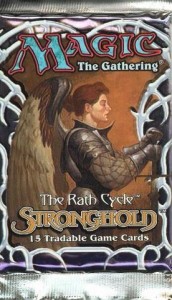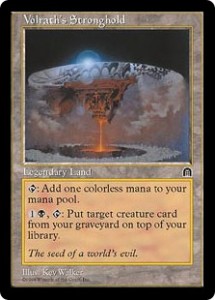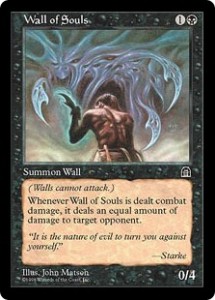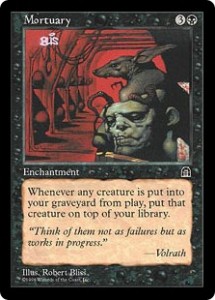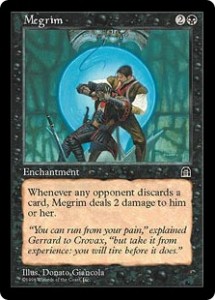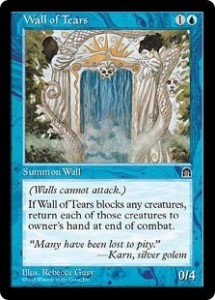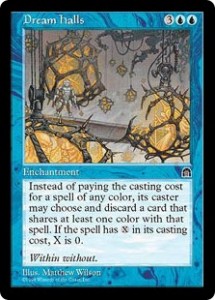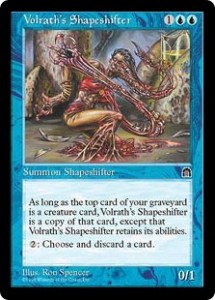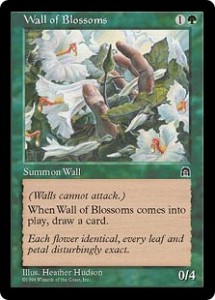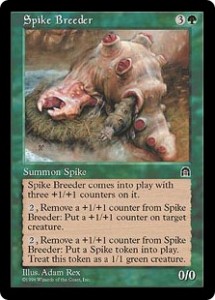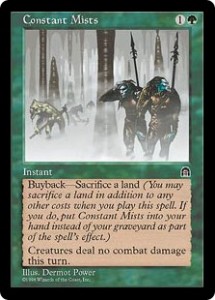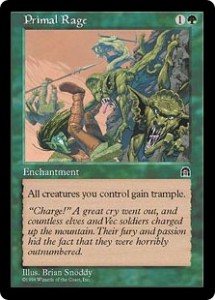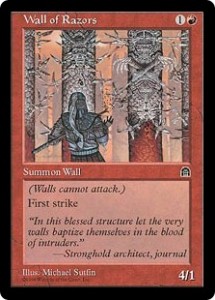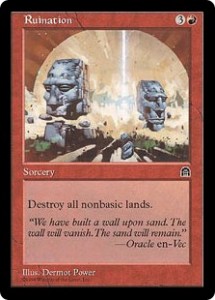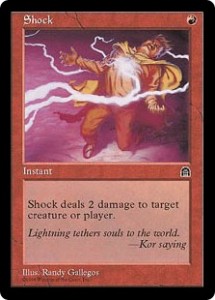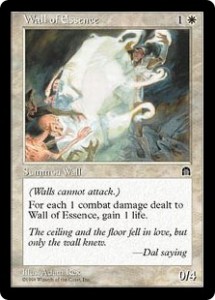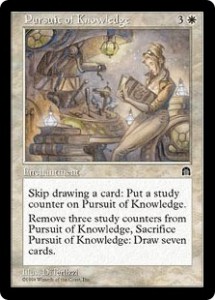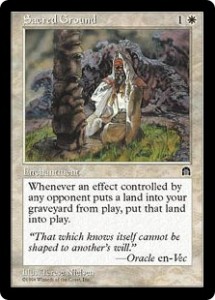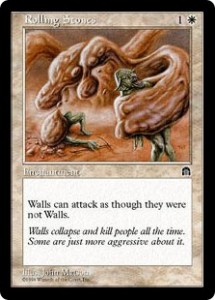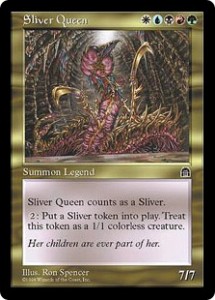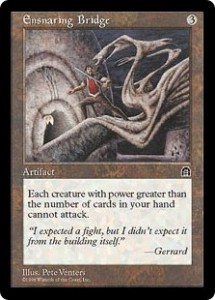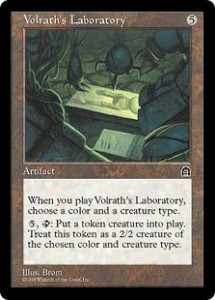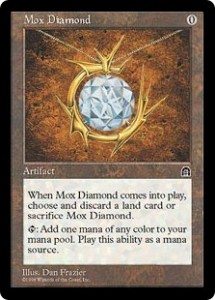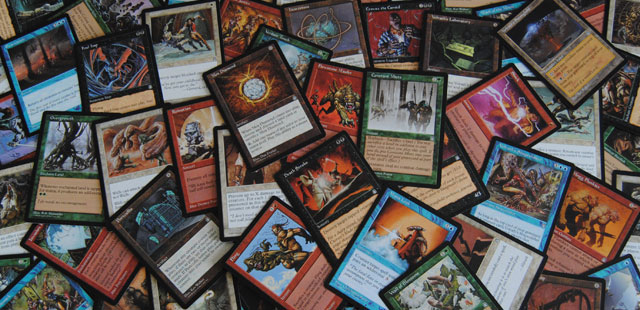
An Introduction to Stronghold
Released in March of 1998, Stronghold was many things; the beginning of the standard for 143 card small expansion sets, down from the old standard of Weatherlight and Visions of 167 cards and it was the first expansion and second set of Tempest: The Rath Cycle.
It continued the themes of Buyback and Shadow from Tempest and created the clan of en-Kor creatures with an ability similar to that of the now defunct Banding ability.
As I stated the set was 143 total cards, with the rarity breakdown of 55 commons, 44 uncommons and 44 rares; including one mythic rare before that was even a real type of rarity. The color breakdown was 25 Black cards, 25 Blue cards, 25 Green cards, 25 Red cards, 25 White cards, 6 Multicolored or Gold cards, 11 Artifacts and 1 Land.
Stronghold also introduced the first Buyback that had Buyback costs that required colored Mana, which was not a major shakeup, but it was the first time Buyback had required more than colorless Mana.
Aside from Buyback and Shadow with the Dauthi, Soltari and Thalakos, the set continued with the Licids, Slivers, Spikes becoming the new Thallids and the great comeback of Walls.
The Land of Stronghold: The one and only Volrath’s Stronghold
The solitary Land of Stronghold was Legendary Land of Volrath’s Stronghold, which is fitting because the set symbol is the closed portcullis of Volrath’s Stronghold. This was only the second Legendary Land, other than Mirage‘s Teferi’s Isle, since Legends itself.
It would also be the last Legendary Land printed until one was printed for each color in Urza’s Saga, after The Rath Cycle (Tempest Block) was finished with its run.
This Legendary Land could be tapped for one colorless Mana or you could pay one colorless and one Black Mana to tap it to “put target creature card from your graveyard on top of your library.”
This wasn’t as much a boon for reanimator decks as it was a boon for many creature based decks in general. Green for example, with it’s multitude of access to Black Mana from Birds of Paradise or Quirion Elves, for example, could use this card most effectively, while other decks could use Charcoal Diamond from Mirage to activate the Land for uses in almost any deck of any color combination.
The Color Black in Stronghold:
Black for Stronghold was great for discard decks, reanimator decks, and weenie sacrifice decks, but more than that it was a great expansion for Black in general.
First off, Wall of Souls was an extremely useful Wall, that went straight into many Black decks once it was removed from the booster pack. “Whenever Wall of Souls is dealt combat damage, it deals an equal amount of damage to target opponent.” This was great great in duals, but even better in melee games, because you get to choose which opponent takes the damage. With Wall of Souls, there are just too many wonderful scenarios that can occur.
Two of the standard Black tribes were given small boosts. The Rats were given a token generating spell with Buyback called Lab Rats as well as Rabid Rats, while Thrulls had Morgue Thrull added to their their ranks.
Dauthi Trapper didn’t have Shadow itself, but it could give target creature Shadow until end of turn, making the total number of the Dauthi clan eight creatures. The Shades a tribe that had been around since Magic’s inception added Dungeon Shade to their ranks, which was just a 1/1 flying Frozen Shade.
Revenant was a flying Lhurgoyf, but it only counted creature cards in your graveyard. This however wasn’t much of an issue, because you could boost your Revenant and hurt your opponent with Grave Pact.
Grave Pact was great for any deck using the sacrifice mechanic to benefit you while hurting your opponents at the same time. It was a simple enchantment, “whenever any creature you control is put into any graveyard, each other player sacrifices a creature.” For all of the sacrificing that Black could do for their own empowerment, it now hurt opponent’s even more.
But for an even more unfair advantage, using Grave Pact with Mortuary was simply beyond the page. Mortuary was an enchantment, “whenever any creature is put into your graveyard from play, put that creature on top of your library.” Now you could sacrifice creatures to your heart’s content, making your opponent sacrifice a creature as well and you’re going to draw those creatures again in the next few turns.
Stronghold even gave Black a complete deck with Grave Pact, Mortuary and Stronghold Assassin, a royal assassin that required a creature sacrifice as part of it’s activated ability, allowing you to kill two creatures at once, without actually losing anything for very long.
Add to the mix Crovax the Cursed, which was great with Breeding Pit and you’d really have quite the deck. Although Crovax was one of the few vampires of it’s day that didn’t have flying, it came into play as a 4/4 because of the four +1/+1 tokens it had one it. During your upkeep, either removed a +1/+1 counter from it or sacrifice a creature to add a +1/+1 counter. You wouldn’t even have to attack, just keep sacrificing creatures and drawing them again, until Crovax is huge and your opponent has no army left.
If a creature managed to get in the graveyard and stay there Tortured Existence allowed you to discard a creature card to return a creature card from your graveyard to your hand, in essence, trading one creature for another. This was great for reanimator decks, but was widely used for Black decks in general.
Brush with Death was a Drain Life for two at a discount of one Black Mana with Buyback and Mind Peel for discard which also had Buyback and both had Buyback costs of two colorless and two Black Mana.
Discard decks were thoroughly boosted in power by Bottomless Pit and Megrim. Bottomless Pit was an enchantment that made each player discard a card at random during their upkeep. This was great on its own, but with Megrim it was extremely powerful.
Then again, any discard card was made that much more powerful with Megrim, an enchantment that dealt two damage to any opponent when that opponent discards a card.
Now, hymn to Tourach not only made them discard two cards, it dealt them four damage and Mind Twist was almost like a direct damage spell. Discard decks quickly incorporated Megrim as a deck standard and those decks became even more dangerous to play against.
The Color Blue in Stronghold:
Stronghold’s Blue didn’t just add to the existing Counterspell arsenal and move on, it added some big mass card removal and protection as well as plenty of bounce back, boomerang type cards.
Wall of Tears was, in essence, the blocking Boomerang because any creature block by it was returned to owner’s hand at the end of combat. It may only bounce back creatures, but it had a powerful effect on the decision of your opponent to attack and what to attack with.
Yes, this is Blue so of course there were counters added to the spell library. Mana Leak, for example, was a Power Sink for three that only cost one colorless and one Blue Mana, which is quite the bargain.
Hesitation a cheap enchantment at one colorless and one Blue Mana, was a Counterspell for the next spell cast. Cheap in cost, it made your opponent think about their next spell, and if you had a Counterspell in hand, you could take care of two opponent spells in the same turn, without paying for both Counters that turn.
Rebound was a cheap Deflection but for spells that target a player. No matter it could still redirect that damage from you back to your opponent and that’s worth the cheap cost.
Intruder Alarm allowed for much control over the game without the need for Stasis. When playing with Counterspells, you could invariably decide when things untap, but when you cast creatures or when you allow your opponent to cast creatures.
Evacuation was a Boomerang Wrath of God, which was a great way to clear the board for your own protection or for any other advantage you may want to play with it. Speaking of advantage, if your opponent has you utterly outnumbered, Reins of Power could turn the table on any game in which it was cast.
Reins of Power was an Instant, “you and target opponent each untap and gain control of all creatures the other controls until end of turn. Those creatures are unaffected by summoning sickness this turn.” In doing this, you could attack, or sacrifice, or utilize an opponent’s army against them.
Dream halls could also change the game in innumerable ways when it was cast. It was a great enchantment for Blue making all spells a Force of Will, so to speak, although it did affect all players. I still maintain that when cast, it was more useful to Blue than any other color.
Of course as an expansion to Tempest, the Thalakos clan was present to add more Shadow options for Blue and the Merfolk tribe was alive and well with Tidal Warrior. The Warrior was a Merfolk that could turn any land into an Island. This was great for any big Islandhome creature you happen to have.
Mind Games was a Twiddle, of sorts, with Buyback that could only tap things, but like some of its Black Buyback compatriots it had colored Mana in its Buyback cost.
Library manipulation, which became a common theme in Magic thanks to Ice Age and Alliances had more options to choose from in Stronghold thanks to Ransack. It allowed you to, “look at the top five cards of target player’s library. Put any number of those cards on the bottom of that library in any order and the rest on top of the library in any order.” This could be used on yourself for a card advantage or on your opponent. Either way, control was in your hands with Ransack.
Mask of the Mimic, allowed you to sacrifice a creature for a copy of that creature and put that copy into play. When used with Black’s Mortuary, this allowed you to have a two for one. Since Mask of the Mimic had a colon after sacrifice a creature, it could also be a two for four or even three for six advantage, once you recast the sacrificed creatures that were put on top of your library thanks to Mortuary.
The importance of your graveyard wasn’t always utilized in Blue, but with Volrath’s Shapeshifter, your graveyard came into play. “As long as the top card of your graveyard is a creature card, Volrath’s Shapeshifter is a copy of that card, except that Volrath’s Shapeshifter retains its abilities.” Now the power of this card, was in its other ability, to pay two colorless Mana to “choose and discard a card,” which of course should be a creature that could be copied.
The only downside, was that once the Counterspell you used goes into the graveyard, the Shapeshifter becomes a mere 0/1 and that’s not scary to anyone.
The Color Green in Stronghold:
Green didn’t just get the standard of creatures and life gain, it also had quite possibly the best of all the Walls of Stronghold in Wall of Blossoms.
Wall of Blossoms was simply one colorless and one Green Mana casting cost 0/4 Wall that allowed you to draw a card when it came into play. For Green, this kind of card draw and defender protection on turn two, if you’re lucky, is an amazing advantage. Although it doesn’t have the constant abilities of some of the other Stronghold Walls, Wall of Blossoms was still the most utilized of them all.
Two Elves were added to the tribe in Skyshroud Archer and Skyshroud Troopers, but it was the Sorcery of Elven Rite, that made the tribe proud. Although it would have been even more useful as an Instant, this Sorcery allowed you to “put two +1/+1 counters, distributed any way you choose, on any number of target creatures.” This was huge because it put permanent +1/+1 counters on the creatures, as opposed to the temporary counters of, for example, Alliances‘ Bounty of the hunt.
As introduced in Tempest with Spike Drone, the Spikes were The Rath Cycle equivalent of Fallen Empires’ Thallids and Stronghold was their coming out party. Five in all were added to the existing one; Spike Breeder, Spike Colony, Spike Feeder and Spike Soldier.
All were 0/0 and relied on +1/+1 counters that could be removed to either give a +1/+1 counter to another creature, gain two life, or create 1/1 Spike tokens. But it wasn’t all Elves and Spikes.
Carnassid was a 5/4 trample with regeneration, one of the not so common creatures with both trample and regeneration, Lowland Basilisk was a smaller version of Thicket Basilisk and Endangered Armodon was a cheap 5/4 but it had to be sacrificed if you controlled any creature with toughness two or less.
But it wasn’t all about tribes and creatures. Two Buyback spells were great additions to Green; Verdant Touch and Constant Mists.
Verdant Touch was a Buyback spell that could turn Land into a creature 2/2 creature permanently. This was great for late in games, when the Mana source rich Green decks had more Land than they could use. But the highlight of the Buyback spells in Stronghold was Constant Mists.
Constant Mists was a Fog that had a steep Buyback, although it was extremely useful. The Buyback cost was to sacrifice a land, but when choosing between sacrificing a land and dying, it’s no contest. The other thing about Constant Mists, was that is was more valuable than Zuran Orb, as one land could gain you two life, or it could prevent, in all likelihood, more than two damage. In shear value, the Constant Mists could save you more often than the Orb.
When looking for ways to gain life, alternatives to Zuran Orb would include Volrath’s Garden. The Garden was an enchantment that allowed you to pay two colorless Mana and tap a creature you control to gain two life and it could be done more than once. Obviously, this is best done at the end of your opponent’s turn, but when you need to gain life, you don’t usually have the luxury of waiting.
Before Stronghold, Green was highly susceptible to the Winter Orb and Stasis control decks, but Awakening was the anti-Stasis, anti-Winter Orb, anti-Static Orb enchantment Green had been waiting for. “At the beginning of each player’s upkeep, untap all creatures and lands.” This was a game changer, when playing against Blue control.
Mana advantage, to which Green had in abundance, was added to with Burgeoning. This enchantment allowed you to play a Land from your hand whenever any opponent puts a land into play. With the right combination of cards, you can have more than a double Mana advantage if this is played first turn.
More Mana advantage could be found with Mulch, especially when used with Sylvan Library or other library manipulation cards like Tempest’s Scroll Rack. All you do is reveal the top four cards of your library and put any Land into play and non-Land into the graveyard, but if you know you have Land there, it isn’t a gamble at all.
Whether it is used for your own Mana advantage or to Mana burn your opponent, Overgrowth was a double Wild Growth, although the second use died away when Mana burn was removed from the rule book.
For any deck based upon amassing creatures, such as is commonly the case with Green, getting damage through is the objective and nothing gets that accomplished faster than creatures with Trample. Enter Primal Rage, which is an enchantment that simply gives all of your creatures trample.
The Color Red in Stronghold:
Red’s Stronghold arsenal was a deadly as ever; direct damage, offensive spells and quick and deadly creatures.
Red’s Wall from the great Wall comeback of Stronghold was the 4/1 first striking Wall of Razors. It might not have dealt damage, or let you draw a card, but it could easily take care of most creatures cast in the first few turns.
Fanning the Flames added a Buyback direct damage X spell for Red, but as Sorceries go, it was the expensive Flame Wage that was was most dangerous. The expensive Flame Wave cost three colorless and four Red Mana, but it was a targeted Earthquake and hurricane in one, that only damaged the targeted player and all their creatures and not yours for four damage.
Defensively, Red had heat of Battle, which dealt one damage to a creature’s controller, whenever any creature blocks. This was something special when paired with Invasion Plans, which stated, “each creature blocks whenever able.” Invasion Plans also had the added ability of “attacking player chooses how each creature blocks,” which can make for interesting attack phases.
Of course the Goblin clan of Mogg was out in full force, adding Mogg Bombers, Mogg Flunkies, and Mogg Maniac as well as Mogg Infestation. The Infestation destroyed all creatures target player controls and replaced each creature destroyed with 1/1 Goblin tokens. Many Goblin decks were also aided by Mob Justice, a Sorcery that dealt target player one damage for each creature you control, which late in the game could be a large amount.
Amok, an enchantment similar to Fallen Empire’s Dwarven Armorer, allowed you to discard a card to put a permanent +1/+1 counter on target creature, which was great for boosting Goblin decks late in games, when you had unnecessary Land in your hand.
Seething Anger was another way to boost your creatures as a Buyback Instant that gave target creature +3/+0. Personally, I like to think of it as a kind of Buyback Blood Lust.
Of destruction, based upon the influx of nonbasic Lands into Magic the Gathering since Ice Age, Ruination was death. It was the Red Armageddon of nonbasic Lands, which simply stated, “destroy all nonbasic lands.”
By the time Stronghold was released, Red had quite a few cards that could be returned from the graveyard and Shard Phoenix was an addition to these cards. Although the Phoenix cost alot, four colorless and one Red Mana, for just a 2/2, the Pheonix could be returned to your hand for three Red Mana and could be sacrificed to deal two damage to each creature without flying. This was one of the few cards that was useful in spite of it’s expense.
No matter, what I have catalogued of Red in Stronghold to this point, two cards stood clearly above the rest; Shock and Fling.
Shock may have done one less damage than Lightning Bolt, the card which it replaced in future core sets, but since Lightning Bolt has stopped being printed, it was the best one Red Mana direct damage spell in the game.
In spite of the fact that Ice Age’s Incinerate had been reprinted in Mirage and Fifth Editions, Shock would soon replace Incinerate, as well. One of the more interesting things started to happen with Shock. Players who had played with Lightning Bolt, used it but lamented the one less damage, while players who started playing after Tempest didn’t have anything to lament.
It was rough for Old School players to take, having had Lightning Bolt get replaced by the more expensive Incinerate, to have that replaced by the less expensive, less damage Shock was a lot to deal with. But with Shock in Stronghold came Fling and that was something to be celebrated.
Fling was a game changer and often a game ender. Fling allowed you to sacrifice a creature to deal damage to target creature or player equal to the sacrificed creature’s power.
This meant that your 10/1 Blood Lusted Ball Lightning could serve the purpose of being sacrificed before it died to deal 10 damage to your opponent for seven Mana, which is quite the bargain.
For all the lamenting or the Lightning Bolt that was done by players of Red, there was just as much celebration over Fling and possible more as the possibilities were quite limitless.
The Color White in Stronghold:
Straight White decks and decks that contained White were very happy with the additions to White’s arsenal in Stronghold. And Walls played a big part in that as did a remnant of the now defunct Banding ability..
Second to Green’s Wall of Blossoms, Wall of Essence was the second most used Wall in Stronghold’s great comeback of Walls. Wall of Essence gained you one life for each one point of combat damage dealt to it. Early in the game, this could either protect you from attack or gain you a lot of life.
The clan of en-Kor; Lancers, Nomads, Shaman, Spirit and Warrior all had the last remnants of the ability formerly known as Banding. Because Banding could be used to redirect damage between two Banded creatures, that is what the en-Kor clan could do, but without the need to Band. And with that Banding was dead.
The Soltari maintained a presence, as a holdout from Tempest, with Soltari Champion, who gave all other creatures you control +1/+1 when it attacked. One the bigger end of the creature spectrum, Warrior Angel was a 3/4 flying Angel with a built in Spirit Link although it did cost four colorless and two White Mana to cast.
Wall of Essence and Warrior Angel weren’t the only life gain for Stronghold’s White; Contemplation gained you a life whenever you successfully cast a spell, while Venerable Monk gained you two life when it came into play. Additionally, Bandage was a tremendously useful one White Mana costing “Prevent 1 damage” Instant with a cantrip.
White card draw was not limited to cantrips, because Pursuit of Knowledge was in the set. Skip drawing a card to put a counter on Pursuit of Knowledge and when three counters were on it, sacrifice it to draw seven cards. Now the benefit of this enchantment was that it wasn’t “skip your draw phase,” it was skip drawing a card, so that includes cantrips and the other card draw from Alliance‘s spells.
Of course there was some straight up protection. Change of heart was a Buyback “target creature cannot attack this turn,” while hidden Retreat was a great way to deal with damage from a sorcery or instant, if you had cards in your hand. It was exponentially more protection from Red and Black than any other color, but any damage dealing Instant or Sorcery could be prevented by dropping a card from your hand to your library. This was great because it didn’t require you to lose the card, just redraw it again next turn.
Conviction was a bigger holy Strength at +1/+3, that like many other creature enchants of the time, could be returned to your hand and recast as needed. But like always two cards stood above the rest; Sacred Ground and Rolling Stones.
Sacred Ground was an enchantment that protected your lands from your opponents. It was the ultimate defense against land destruction decks. “Whenever an effect controlled by any opponent puts a land into your graveyard from play, put that land into play.”
What more can you say, if they try to destroy it, it just comes right back, which renders their land destruction deck useless, unless they built in another theme and can hit you with something else.
Sacred Ground was mainly used as a sideboard standard for White tournament decks of the time, but as prevention against one type of deck goes, this was pretty lockdown.
Rolling Stones on the other hand, was a card to built a deck around. In addition, to the five Walls that brought back the usefulness of Walls, Rolling Stones completely changed the way we looked at Walls to begin with.
“Walls can attack as though they were not Walls.” Considering the enchantment only cost one colorless and one White Mana, this enchantment was a big deal. This was Animate Wall for all Walls and not just one.
Most Walls are cheaper than other creatures with the same power or toughness, because Walls can’t inherently attack. This means that if you build a Rolling Stones deck, you can be looking at an arsenal and army of lots of creatures that are cheaper than they would normally be, but at the same time, the only offense your deck will have is when you cast Rolling Stones.
That being said, it is still a great deck concept that gets revisited with every wall that gets printed with every new set that comes along.
The Gold of Stronghold: The Sliver Queen Emerges
The Slivers of Tempest were not left out of Stronghold, except that there were no straight, solid colored Slivers in Stronghold, they were all multicolored or Gold. There were five Slivers and one Legend, the Sliver Queen in the set.
The five Slivers were all 2/2’s with varying abilities, but it was the Sliver Queen, a 7/7 Legend, that rose to lead the now burgeoning tribe of Slivers.
Sliver Queen, which counted as a Sliver, could create Sliver tokens for two colorless Mana and although the Queen cost one Mana of each color to cast, it was worth casting.
Getting a Sliver Queen into play for a Sliver deck was paramount, although keeping the Queen around was just as important. The Sliver Queen made Slivers a force to be reckoned with.
The Artifacts of Stronghold:
Although there were only 11 Artifacts in Stronghold, all of them were useful in their own way and two stood above the crowd.
Bullwhip dealt one damage to target creature and that creature attacked this turn if able. Ensnaring Bridge made any creature with a power greater than the number of cards in your hand, unable to attack, which was great if you had no cards in your hand.
Heartstone made creature activation abilities cheaper by one colorless Mana and horn of Greed allowed you to draw a card, whenever any player plays a land. The hornet Cannon made 1/1 flying creatures that were unaffected by summoning sickness and destroyed at the end of the turn, while Jinxed Ring dealt damage to you whenever any card is put into your graveyard from play, but you could sacrifice a creature to give the Ring to target opponent.
Portcullis, as long as it remained in play, would only allow the two or more existing creatures already in play to remain there, while any further creatures would be set aside until Portcullis left play. Continuing the Walls of Stronghold theme, was Shifting Wall an X costing Wall, where X would be equal to the number of +1/+1 counters on it. While, Sword of the Chosen would give target Legend +2/+2 until end of turn.
But the two Artifacts of Stronghold that stood above and beyond where Volrath’s Laboratory and the mythic Mox Diamond.
Volrath’s Laboratory allowed you to choose a color and a creature type when it was cast. From then on, if you payed five colorless Mana and tapped it, you could create a 2/2 token creature of the chosen color and type.
This was great for Elves and Goblins, but not just because it would add more numbers to your ranks. You could create Blue Elves or White Goblins to get around Circle of Protections if you needed to. That was one of the truly great abilities of the Laboratory.
But everything bowed down to the Mox Diamond. This was the Mox that could have been in Mirage when it was changed to be the Lion’s Eye Diamond, just before printing.
Apparently, for Stronghold the set creators had found a way to balance the card and bring back a Mox into modern play. The cost they balanced out the power with was to discard a land card when Mox Diamond came into play.
That being said, unlike the rest of the Moxen, the Mox Diamond could be tapped for any color of Mana, and thus most players were more than willing to sacrifice a Land for its ability.
Mox Diamond was restricted, almost the second it was printed, but it was still a welcome return to the power cards of Old School Magic, which many older players had been clamoring for. Did it monumentally change the game? Nope, but it did enhance decks left and right, which is saying something, considering it didn’t matter what deck it was, it was usually better with a Mox Diamond in the deck.
In Conclusion Stronghold

Magic the Gathering Stronghold Set Symbol
Even though the set numbered 143 cards, there is a lot to digest from a select few. The reemergence of Walls and the coming out party for the Sliver Queen. The torchbearer of Lightning Bolt in Shock and the return of a Mox in Mox Diamond. A new Legendary Land and the death of Banding.
Stronghold really did cover a lot of bases. Of course, it set its sights extremely high for a mere expansion set and one following the new 143 card format at that.
Stronghold was a very strong followup to Tempest and in some ways it eclipses the set it expanded upon. But it wasn’t the first expansion to do so, because Alliances’ also, in many ways, eclipsed Ice Age. Although Stronghold didn’t change the game as much as Alliance’s did, it still had an immense impact on Magic, but the Old School way of playing and the future of sets yet to come.
